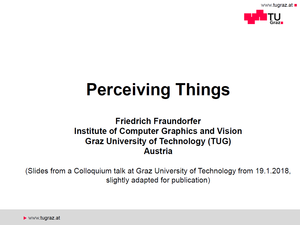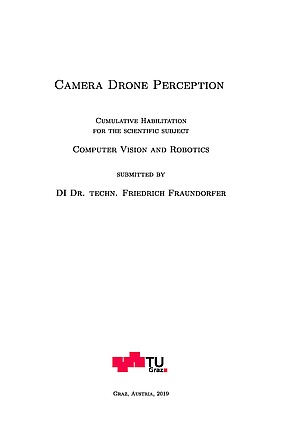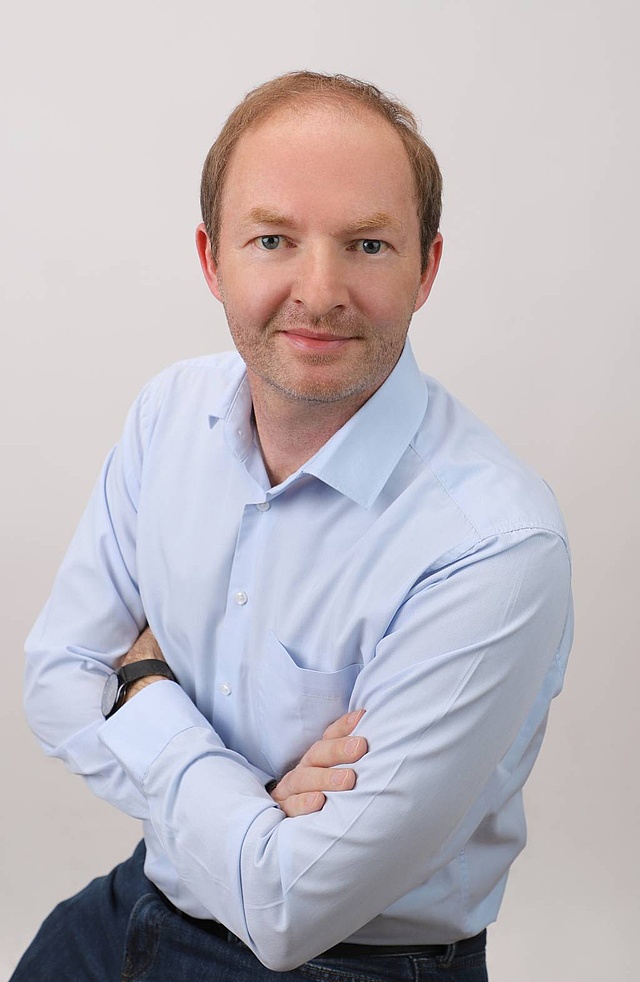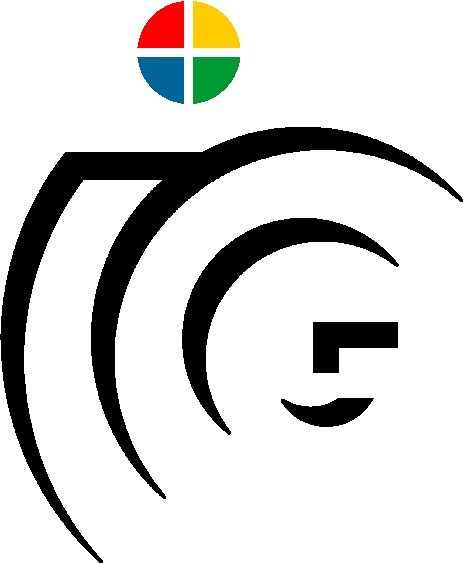Friedrich Fraundorfer is Professor at Graz University of Technology. He received the Ph.D. degree in computer science from TU Graz, Austria in 2006 working at the Institute of Computer Graphics and Vision headed by Franz Leberl and Horst Bischof. In 2006 he joined the group of David Nister (now VP at NVIDIA) at the University of Kentucky as a post-doc researcher. He collaborated with Henrik Stewenius (Google) and others on large scale image search and 3D computer vision. In 2007 he joined the group of Marc Pollefeys at the University of North Carolina at Chapel Hill as a post-doc researcher to work on large scale 3D reconstructions collaborating with Jan-Michael Frahm, and Changchang Wu (Google). In 2007 the group moved to ETH Zurich, Switzerland, where he had a lecturer position at the Computer Vision and Geometry Lab headed by Marc Pollefeys. From 2012 to 2014 he acted as Deputy Director of the Chair of Remote Sensing Technology at the Faculty of Civil, Geo and Environmental Engineering at the Technische Universität München.
Friedrich Fraundorfer is involved in multiple international and multinational research projects as project leader, investigator and collaborator. The international EU Project SFly has been a collaboration between many renowned institutions, ETH Zürich, INRIA, Technical University of Crete, Centre Suisse d'Electronique et de Microtechnique SA, Centre for Research and Technology, Hellas, Ascending Technologies. The SFly project had the objective to develop autonomous small scale micro aerial vehicles (MAV) that are controlled by onboard cameras and pushed the limits in robotics and robot vision on an international scale. The final project demonstration showed autonomous operation of 3 micro aerial vehicles performing 3D mapping of unknown environments for a search and rescue mission. He also lead a 4-year national funded SNF project to develop a fully autonomous operating micro aerial vehicle (SNF MAV). The develop MAV system is capable of autonomously exploring unknown environments, avoiding obstacles and creating a 3D environment map using only cameras as it sensors. The system has been presented at IROS 2012 where it has been nominated for Best Paper Award. He has been scientific advisor to the student driven Pixhawk project, with the goal of creating an open source and open hardware MAV platform. The hardware and software created in this project is used in leading institutions worldwide. Friedrich Fraundorfer has also been involved in the development of self-driving cars. The EU Project VCharge is an international collaboration between ETH Zürich, Volkswagen AG, University of Oxford, Università degli Studi di Parma, Technische Universität Braunschweig and Robert Bosch GmbH. Its goal is to create an autonomously driving car using cameras as the only sensor modality. The car will be able to map and perceive the environment with cameras, driving safe and react on obstacles in its path. The vehicle will make use of a multi-camera system that allows a 360 degree omnidirectional view to map and perceive its environment. Challenges are to track the movement of the vehicle by using the camera system only, and to create a environment description that can be used for navigation and safe driving.
Tutorial on Visual Odometry:
Together with Davide Scaramuzza (University of Zurich) Friedrich Fraundorfer published a two-part tutorial about visual odometry in the IEEE Robotics and Automation Magazine.
- Davide Scaramuzza and Friedrich Fraundorfer. Visual odometry : Part I : The first 30 years and fundamentals. Robotics Automation Magazine, IEEE, 18(4):80-92, dec. 2011. (PDF)
- Friedrich Fraundorfer and Davide Scaramuzza. Visual odometry : Part II : Matching, robustness, optimization, and applications. Robotics Automation Magazine, IEEE, 19(2):78-90, june 2012. (PDF)
Online lecture on micro aerial vehicles:
As part of Jürgen Sturm's online course "Visual Navigation for Flying Robots" a lecture by me about "Autonomous micro aerial vehicles" is available online. (LINK)
Camera drones lecture:
In 2016 the first round of my "Camera drones" lecture has started. Check out the cool student projects created in this course on our droneSpace webpage.
Colloquium talk:
|
Slides of a Colloquium talk about "Perceiving things" hold on 19.1.2018.
|
 |
Computer vision algorithms make computers see, to let them perceive their environment and to allow them eventually interact with it. This does not apply to desktop computers only, but to every computing "thing". This is made possible by complex computer vision algorithms, that are designed to extract information from images needed to interpret and understand the environment in a similar way as done by the human visual system. Important information in this sense are 3D measurements and object labels, i.e. semantic information.
"Camera Drone Perception" Book:
|
A book with the title "Camera Drone Perception" containing a selected collection of my research in robotics and computer vision.
|
 |
Teaching:
Winter term
Summer term
Supervised students:
Michael Maurer, Thomas Holzmann, Fabian Schenk, Christian Mostegel, Markus Bergen (Rumpler), Tobias Koch, Xiangyu Zhu, Gim Hee Lee, Olivier Saurer, Lorenz Maier, Petri Tanskanen, Gellért Máttyus, Lionel Heng, Florian Burkhart, Rafael Weilharter, Nikolaus Heran, Christoph Herzog, Philipp Reitter, Jörg Schlager, Jaka Cikac, Pascal Dufour, Diego Browarnik, Ingo Jenni, Christian Dobler, Arnold Irschara, Thomas Mauthner, Sandra Ober, Andreas Johann Schütz, Moritz Brunnengräber
Most cited works:
- Friedrich Fraundorfer, Christopher Engels, and David Nist�er. Topological mapping, localization and navigation using image collections. In IEEE/RSJ Conference on Intelligent Robots and Systems, volume 1. IEEE, 2007.
- Davide Scaramuzza, Friedrich Fraundorfer, and Roland Siegwart. Real-time monocular visual odometry for on-road vehicles with 1-point ransac. In 2009 IEEE International Conference on Robotics and Automation, 2009.
- Friedrich Fraundorfer and Horst Bischof. A novel performance evaluation method of local detectors on non-planar scenes In Workshop Proceedings Empirical Evaluation Methods in Computer Vision, Conference on Computer Vision and Pattern Recognition (CVPR), 2005, IEEE Computer Society, 2005, 2005.
- Davide Scaramuzza, Friedrich Fraundorfer, Roland Siegwart, and Marc Pollefeys. Absolute scale in structure from motion from a single vehicle mounted camera by exploiting nonholonomic constraints. In Proc. 12th IEEE International Conference on Computer Vision, Kyoto, Japan, 2009.
- Friedrich Fraundorfer, Konrad Schindler, and Horst Bischof. Piecewise planar scene reconstruction from sparse correspondences. Image and Vision Computing, 24(4):395-406, 2006.
Research Interests
3D Computer Vision, Robot Vision, Multi View Geometry, Visual-Inertial Fusion, Micro Aerial Vehicle, Autonomous Systems, Aerial Imaging
Universities
Technische Universität München, ETH Zürich, University of North Carolina at Chapel Hill, University of Kentucky, Graz University of Technology
Projects
SFly, SNF MAV, VCharge, Pixhawk
Publications:
Publication list on the TUG PURE portal.
Google Scholar, DBLP




